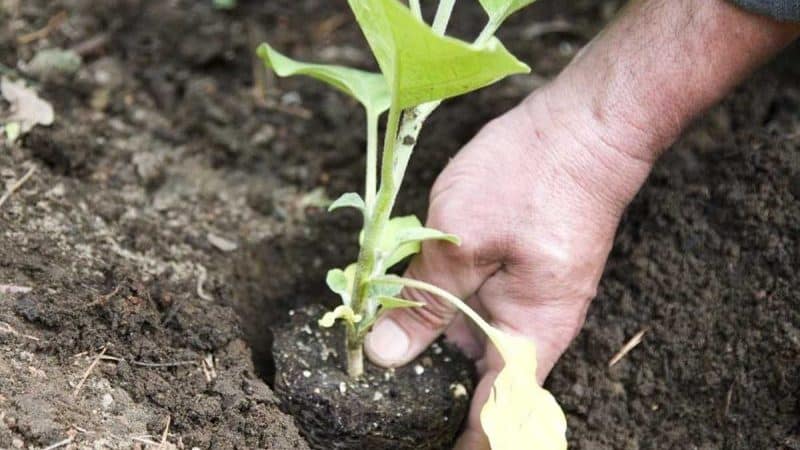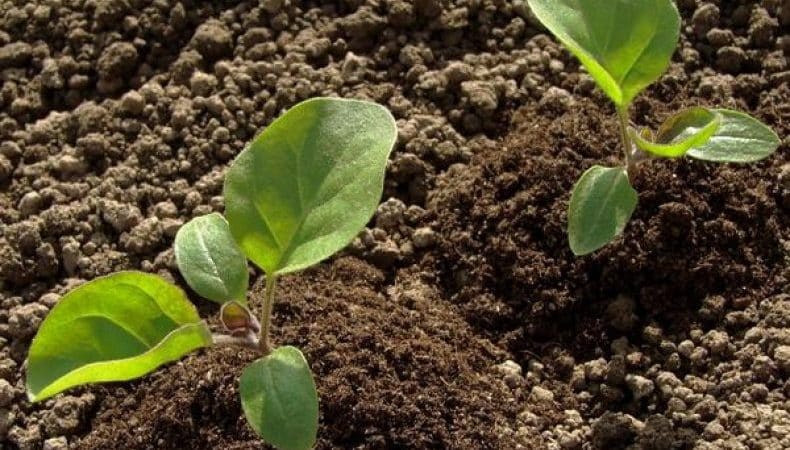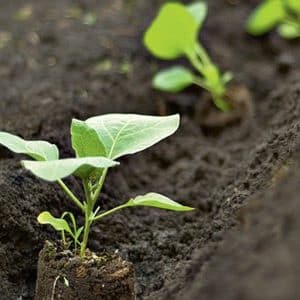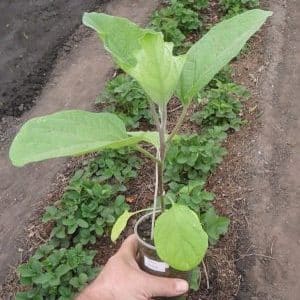Features of planting eggplants in open ground
Eggplants contain vitamins A, B, C, trace elements calcium, magnesium, fluorine, iron. Eating this vegetable lowers cholesterol levels and strengthens the immune system. In order not to look for fresh eggplants in the store, many grow them on their own plot. The vegetable requires care and adherence to basic agrotechnical rules, but the main condition for success is to choose the appropriate variety and follow the planting rules.
In this article we will tell you how to plant eggplants in open ground and reveal the secrets of a rich harvest.
Which eggplant varieties are suitable for growing in open ground?
For sowing in open ground, cold-resistant and unpretentious varieties are usually chosen. The plant must have strong immunity to sudden weather changes. The following varieties and hybrids are suitable for open ground:
- Diamond. Compact bushes reach a height of 50-60 cm. The weight of the vegetable varies from 120 to 160 g, length is about 15 cm. The peel is glossy, rich dark purple in color. The pulp is green, without bitterness.
- Faith. The early ripening variety ripens in 110-120 days from the moment the first shoots appear. The height of the bush is 70 cm, weight is about 200-250 g. The variety is universal in use, suitable for preparing stuffed, baked and stewed dishes.
- Bourgeois f1. An unpretentious and cold-resistant hybrid has strong immunity to diseases and pests. Plant height is 1.5 m, fruit weight is 400-600 g. The pulp is white, not bitter.
- Black opal. The popular variety Black Opal is distinguished by elongated cylindrical fruits.Eggplant weight is about 200 g, length 20-25 cm. The peel is dense and glossy. The pulp is light beige, with a pleasant taste.
- Alekseevsky. Plant height is 70 cm, vegetable weight is 100-140 g. The shape is cylindrical, slightly pointed towards the tips. The Alekseevsky variety is distinguished by its stable high yield and unpretentiousness.
Important! When choosing seeds, trust trusted agrotechnical companies. When purchasing, pay attention to the integrity of the packaging and the expiration date of the seed.
Preparing the bed
Eggplants are planted on loose and fertile soils. The culture prefers a mixture of loamy and sandy loam soils, windless beds located away from groundwater. The bed for eggplants is prepared in two stages.

in autumn
In mid-October, the beds are cleared of plant debris, debris and weeds. Dig the soil onto the handle of a shovel and level it with a rake. Dry manure is suitable for fertilizing - it will saturate the soil with nutrients over the winter.
in spring
After the snow melts, the beds are dug up again, breaking up large clods of earth with a shovel. Fertilize with vermiculite, a mineral that saturates the soil with vitamins and minerals. Make row spacing, the size of which depends on the type of eggplant.
The classic planting pattern is 60x60. A mixture of dry lime and wood ash is added to soil with high acidity.
Growing from seeds
It is advisable to sow eggplant seeds in warm regions with a temperate climate without sudden temperature changes. After purchase, the seeds are inspected for external defects. Specimens with stains or other damage are removed.
Features of preparation for cultivation
The first stage of preparation is testing for germination. The seeds are placed in a jar of salted water and stirred.The seeds that have sunk to the bottom are alive and suitable for planting.
The second stage of preparation is disinfection. It is carried out using aloe juice, a weak solution of potassium permanganate or Bordeaux mixture. The seeds are dipped into the solution for 15-20 minutes, removed and dried. Disinfection strengthens the immunity of the future plant and stimulates development.
Important! For best germination, seeds are germinated by wrapping them in a damp cloth for 2-3 days and putting them in a warm place. As soon as the first shoots appear, the material is ready for planting in open ground.
Growing from seedlings

Prepare the container and soil for seedlings. Wooden boxes, plastic cups, and flower pots are used as packaging. The container is thoroughly washed and wiped with a dry, clean towel. The soil is taken from the garden or from the store. Clean soil with neutral acidity is suitable for seedlings. To be safe, it is disinfected with Bordeaux mixture before planting.
How to sow seedlings:
- Soil is poured into the container and grooves are made at a distance of 15-20 cm from each other.
- A little water is poured into each and 2-3 disinfected seeds are placed.
- Sprinkle soil on top and water again.
- The next watering is in 10 days.
Rules for caring for seedlings
For seedlings, you need 10-12 hours of daylight and a warm place. If daylight hours are short, lighting is provided with fluorescent lamps. Water the seedlings as the soil dries, using water at room temperature. To accelerate growth, the Kornevin stimulator is added two weeks from the moment of planting. It will accelerate the development and strengthen the immunity of eggplants.
Fertilize the seedlings with mineral and organic fertilizers. They use liquid bird droppings, herbal infusion, superphosphate, and ammonium nitrate.Fertilizers improve the taste of vegetables and protect seedlings from diseases.
Important! Before planting, the seedlings are hardened - placed in the freezer for an hour for 3-4 days. Hardening helps the plant to quickly adapt to external climatic conditions. The procedure is mandatory for Siberia and the Urals.
Picking
After 20-25 days, the eggplant seedlings are transplanted into a larger container - they are planted. The plant has a developed root system, which over time requires more and more space. If you do not pick eggplants in time, they will become lethargic and weak.
Planting in open ground
When to plant eggplants. Eggplants begin to be planted in open ground in late April-early May, after the last spring frosts. They prepare the beds and make furrows. Sprouts are placed in each and the base of the stem is sprinkled with loose soil and soil crumbs. To add looseness, dry sawdust or river sand is added to the soil.
The recommended planting scheme for compact plants is 60x60, for tall plants - 70x80. In the first week, the bushes are covered with thick polyethylene; it protects the still fragile plants from winds, rains and fogs. After 5-7 days, the plastic caps are removed.
Interesting! The best predecessors for planting crops are cabbage, carrots, beets, greens, and legumes. It is not recommended to plant eggplants after tomatoes, peppers, and potatoes. The vegetable is grown in the same place for no more than two seasons in a row.
Care
The quantity and quality of the harvest directly depends on compliance with the rules of care in the open ground. It must be systematic to provide the plant with nutrients and moisture and protect it from diseases and pests.
Watering

Water the beds once every 5-7 days, about 1 liter is spent per bush. If the summer is hot and rainy, then the amount of moisture is reduced. Water in the morning or evening to avoid sunburn.
The stream is directed under the root, protecting the stems and leaves. Otherwise, moisture on the plant will lead to burns, the development of fungus and viral infections. For convenience, a drip irrigation system is used. Water is used sparingly and goes directly to the root.
Fertilizers
Fertilize the beds every 10-15 days, add organic matter and mineral complexes. Liquid manure, urea, ash, and Bordeaux mixture have a beneficial effect on plant development.
Gardeners use the preparations “Kimira”, “Zdraven”, “Magic Leika”. Before fertilizing, water the soil abundantly. Lack or excess of fertilizers harms eggplants. Therefore, it is important to follow the instructions.
Protection from diseases and pests

Diseases and pests arise due to improper care, non-compliance with crop rotation rules, high humidity and hot weather. Diseases include late blight, blackleg, root rot, powdery mildew; pests include spider mites, aphids and whiteflies.
For prevention, they are sprayed with whey and iodine, and watered with an ash solution. The drugs “Maxim”, “Oxychom”, “Quadris” are used for treatment.
Tying up
Tall varieties of eggplant need gartering - they use wooden stakes driven into the ground and thin strips of fabric. There is no need to tie knots on the plant, just wrap the stem once and make a knot near the peg.
A garter is needed to ensure that the stem and shoots do not break under the weight of the ripe fruit.
Loosening and weeding
Loosening and weeding improves the quality of the soil, making it lighter and looser.Loosen the beds once a week, before watering. Loosening depth – no more than 7 cm.
Weeding includes hilling the bushes and removing weeds. Weeds contribute to the appearance of insect pests, so it is important to get rid of them in a timely manner and maintain a healthy microflora of the beds. Especially a lot of weeds appear after dew and rain.
Collection and storage
Eggplants are harvested a month after flowering. The fruits become elastic and resilient, acquire a rich purple color, and a glossy effect appears. Ripe eggplants have a bright green stalk. You can’t overexpose the harvest - eggplants take on a bitter taste. Cut the fruits using garden shears.
Store eggplants in a cool basement or cellar for one month. The harvest is not washed, placed in dry wooden boxes and covered with newspaper. Vegetables with external damage are eaten immediately after harvest.
Interesting! Eggplants are suitable for preparing vegetable stews, salads and soups. They serve as an ideal basis for stuffing and are combined with meat and fish fillings. Housewives canned and pickled vegetables, adding garlic, horseradish, and pepper to pickles.
Conclusion
Planting eggplants in the ground does not require special knowledge or preparation. The process begins with the preparation of seed material - purchasing and disinfecting seeds, germination and hardening. Eggplants are planted in spacious and warm beds, watered as the soil dries. Fertilizers include organic fertilizers and mineral complexes.
The maturity of vegetables is determined by their glossy purple color and green stalk. The harvest is used to prepare healthy and tasty salads, snacks, and side dishes.